History and heritage
Located south-west of Paris and along the Seine, the city of Issy-les-Moulineaux, which has 69, 941 inhabitants spread over 425 hectares today, has a rich history spanning more than 2000 years.
A 5th century necropolis (near the present-day Saint-Benoît church) is the oldest archaeological evidence, while the etymological roots hypothesized for the name "Issy" go back to the Gallo-Roman, and even Celtic, periods.
Regarding these hypotheses, the most interesting is based on the topology that "Issy" comes from the Gallic word "Ceton" meaning "wood, forest". The Gaulish preposition "Is" also means "under.” Thus, "Issy" would mean "under the wood.” The forests of Meudon and Clamart, located above the city, covered the south-west of the Île-de-France through the 8th and 9th centuries.
Around the fifth century a "villa," or rather,a vast farm which seems to be the origin of the city, developed. The name of the domain is mentioned for the first time in 558 in a Childebert I Charter, in which the king yielded a vast territory of 2,000 to 2,500 hectares on the left bank of the Seine to the Benedictine monks of Saint-Germain-des-Prés.
In the fourteenth century, the area of the territory of Issy was reduced to the proportions we know today. In front of the Saint-Etienne church are buildings such as ovens and banal presses, towers, and fortified houses, which symbolize the dominion of the monks.
This monastic spirit lead Issy into the seventeenth century, a prosperous period.
Issy then became a privileged holiday resort where the Parisian nobility built "houses of the fields.”
Issy fostered a brilliant lifestyle in the image of Marguerite de Valois, first wife of Henry IV. Vast green spaces, the park of the seminary of Saint-Sulpice, and the Henri Barbusse park are vestiges of this grandiose past. The memory of the Conti princes (eighteenth century) still survives in the walls of a museum pavilion. The sumptuous residence of Nicolas Beaujon, then the Duc de l'Infantado, now houses the Hôtel de Ville. The "Petit Logis de Vaudétard" (located along the current street of the same name) represents the 1659 French opera entitled "La Pastorale d'Issy." These wealthy Isséen residences, amongst many others, occasionally hosted high-profile people such as Henri IV, Saint Vincent de Paul, Marie de Medici, the young Louis XIII, and Madame de Sevigne.
Fort d'Issy and the fighting of 1870-1871
The history of Fort d'Issy begins in the 19th century. Built in 1842, it was one of 19 military forts to defend Paris against external threats. Its 21st century transformation into a district of modern life, sustainable development, and digital technology should not overshadow the important role that this military building played in the history of Issy-les-Moulineaux, particularly during the Franco-Prussian war of 1870 and fighting of the Commune of spring 1871.
During the years 1870-71, Paris had to resist two major threats: the first by the Prussians - as part of the War against Prussia (September 1870 - January 1871), the second by the Regular Army of Versailles - as part of the Insurrectional Commune of Paris (March - May 1871).
In both cases, the Parisian defenders occupied Issy to defend at Fort d’Issy. In January 1871, the Fort resisted the Prussians, but during the second seige in May 1871, the Versailles troops took the fort and devastated the town.
Today, many places stand to testify to the events of 1870-1871 in Issy.
1900-1918
The 19th century was a period of profound upheaval for Issy, however, around 1900, growth resumed increase vigor.
At the beginning of the century, disasters in large Swiss factories such as Gévelot and Ripolin hit the headlines. Then, from January 23 to February 2, 1910, the city, along with neighboring towns, suffered from the effects of a particularly devastating flood from the Seine.
Issy, cradle of aviation
Issy-les-Moulineaux became “the cradle of aviation” when pioneers’ in aviation, such as Louis Blériot, brothers Charles and Gabriel Voisin, and Henry Farman undertook aeronautical research to improve plane models in Issy. An expansive field in Issy, previously dedicated to military exercises, was made into an airfield, making Issy into a hot spot for aviation in France, the most active airfield in Paris, and the site of many flight experiments.
For example, the brothers Charles and Gabriel Voisin settled in 1907 to perform their flight tests. The Caudron brothers created a flying school and settled in a workshop at the intersection of the streets Rouget de Lisle and Camille Desmoulins.
Henry Farman stands out with his work done in the field of Issy-les-Moulineaux. As one of the Voisin brothers’ first customers, he used the Voisin 1907 biplane to set several official flight records for distance and duration. He conducted the first passenger flight and the first cross-country flight in Europe, flying from Châlons to Reims, in 1908. In 1919, he opened one of the first airlines open to the public in France.
World War I
With the war, the activity of the aeronautic construction workshops developed further. The years of war corresponded to a sustainable increase in the industrial potential of the town (as in the rest of the Paris agglomeration). At the same time, in response to the fighting taking place on the Front, military hospitals were organized in large educational establishments (Ecole Saint-Nicolas, Seminary of Saint-Sulpice).
Although Issy was struck by a German air raid in 1918 during which a shell hit Corentin Celton Avenue, Issy-les-Moulineaux took part mainly in the war effort as a city in the background. It was home to five military hospitals, one of the most important was the present-day Corentin Celton Hospital, then called Small Household Hospice. Founded in Paris in 1557 and settled in Issy in 1863, the hospital buildings built by architect Marcellin Véra could accommodate nearly 1,300 people.
During the war, the hospice was transformed into a major military hospital to treat the wounded. The war effort also had an impact on the population of the time: at least 860 people lost their lives during the conflict, according to the French Remembrance Committee, an association dedicated to the maintenance of the graves and the War Memorial of the Place Bonaventure Leca.
1918 - 1945
From 1921 to 1936, the population doubled: from 26, 587 to 44, 091 inhabitants
At the same time, Issy-les-Moulineaux suffered various encroachments from its "invasive" neighbor: Paris. The area of the town is reduced to 425 hectares. Thus, the imperative is to build faster and at the best price. Issy then became a new urban landscape. Residential buildings, but also a whole series of collective or social facilities, were expanded.
1945 - 1980
After 1945, Issy had to rebuild and produce. In result, economic activity found new life in Issy.
Some companies and establishments leave Issy-les-Moulineaux, others close definitively. In 1961, the neighborhood around rue Antoine Courbarien was destroyed as a result of the collapse of the quarries.
The economic crisis of the 1970s only accentuated the phenomenon of deindustrialisation. At the same time, the population decreased to 47,561 inhabitants in 1975. Symbolically, the "Gévelot factory", the oldest in the city, was put in judicial settlement in 1980 and finally disappeared in 1992. The industrial vocation of the city is questioned, and a new era begins.
1980 to the present day
Today, the city has succeeded in becoming one of the most economically and demographically dynamic cities in the Hauts-de-Seine.
Businesses in the tertiary sector have replaced the industrial and polluting companies of the last century
With more than 720 businesses / artisans and 800 active businesses, including more than 50% in the communication and information technology sectors, the City has created a powerful economic framework. Since the mid-1990s, Issy has embarked on the path of information and communication technologies and has become a recognized role model, in France and abroad, in this field.
Issy-les-Moulineaux changed its appearance within a few years thanks to a voluntarist and balanced urban policy that allowed the construction of housing and a reconquest of public spaces. Between 1995 and 1999, the surface area of green spaces increased from 42 hectares to 52.5 today (13% of the territory of the commune against 9% on average for the cities of the Paris region). The census results show that Issy currently exceeds the population level in 1962 (51,898 inhabitants at the time). From 1990 to 1999, the city gained 6958 inhabitants, from 46,194 to 53,152. The city has adapted to this context of the end of the century and will continue on this path in the next millennium.
Issy in the 21st century
For more than 30 years, the City of Issy has promoted a changing face, rehabilitating entire neighborhoods. As a result, more than 40% of the city's area is the results of the development of new neighborhoods that respect the environment and have access to new technologies. Issy is now a sustainable city ready for the future and a metropolis city of communication that offers its inhabitants the latest innovations and services.
Today, our city continues to attract new inhabitants (64,069 inhabitants on January 1, 2011) in search of quality of life and services and businesses attracted by its dynamism, its geographical location close to Paris, and the public transportation options. Thanks to its strengths, the city is now home to the headquarters of prestigious companies such as Microsoft, Bouygues Telecom, Sodexo, Coca-Cola, Hewlett Packard, Bull, Canal.
Finally, the creation in January 2010 of Grand Paris Seine West, a community agglomeration that includes the municipalities of Boulogne-Billancourt, Issy-les-Moulineaux, Meudon, Vanves, Chaville, Ville-d'Avray and Sèvres, pushes the horizons as the city now benefits from the synergy of infrastructures and the pooling of resources. Thus, the future of Issy-les-Moulineaux is taking shape such that it can fill the shoes of our motto, "an innovative city where life is good.”


